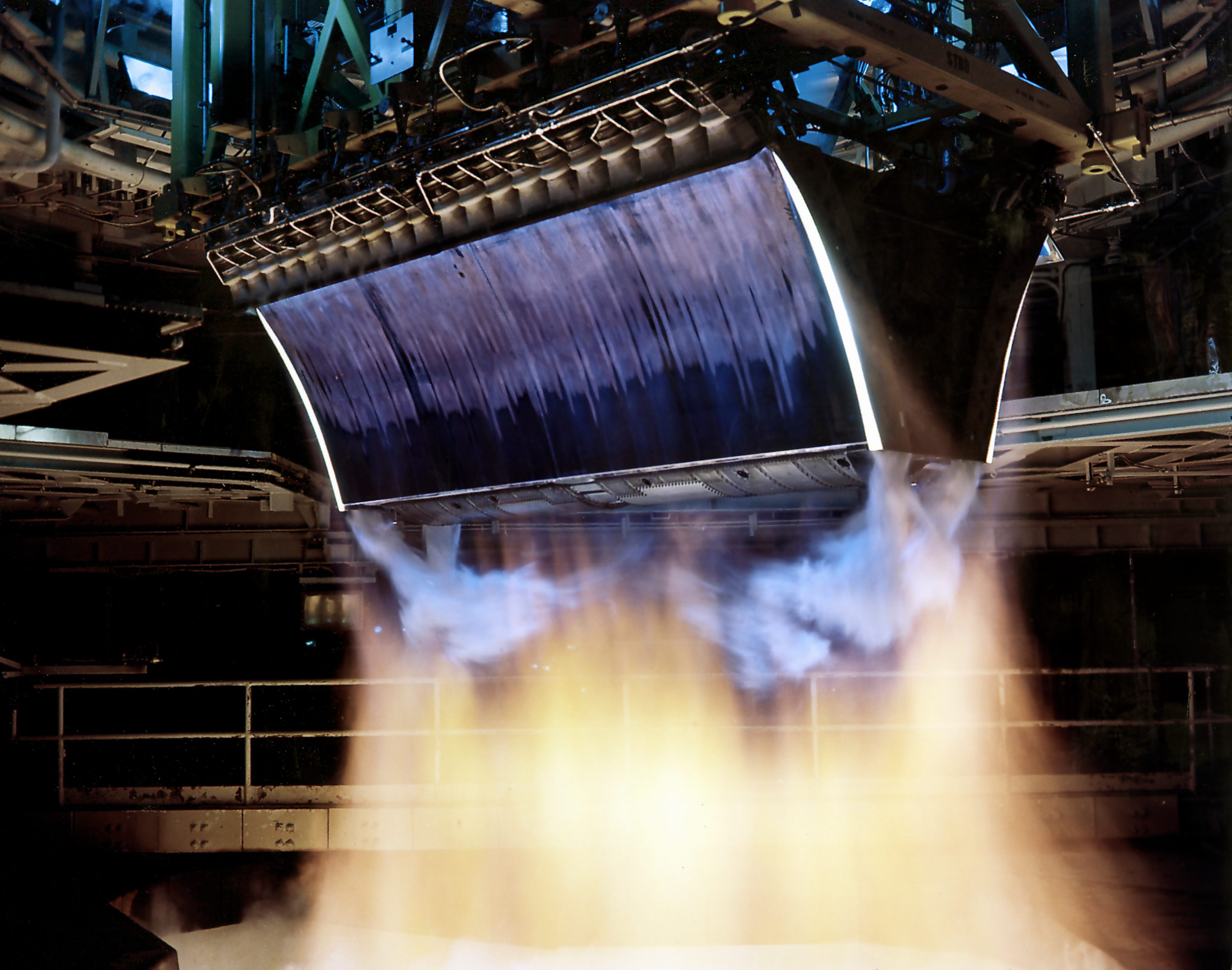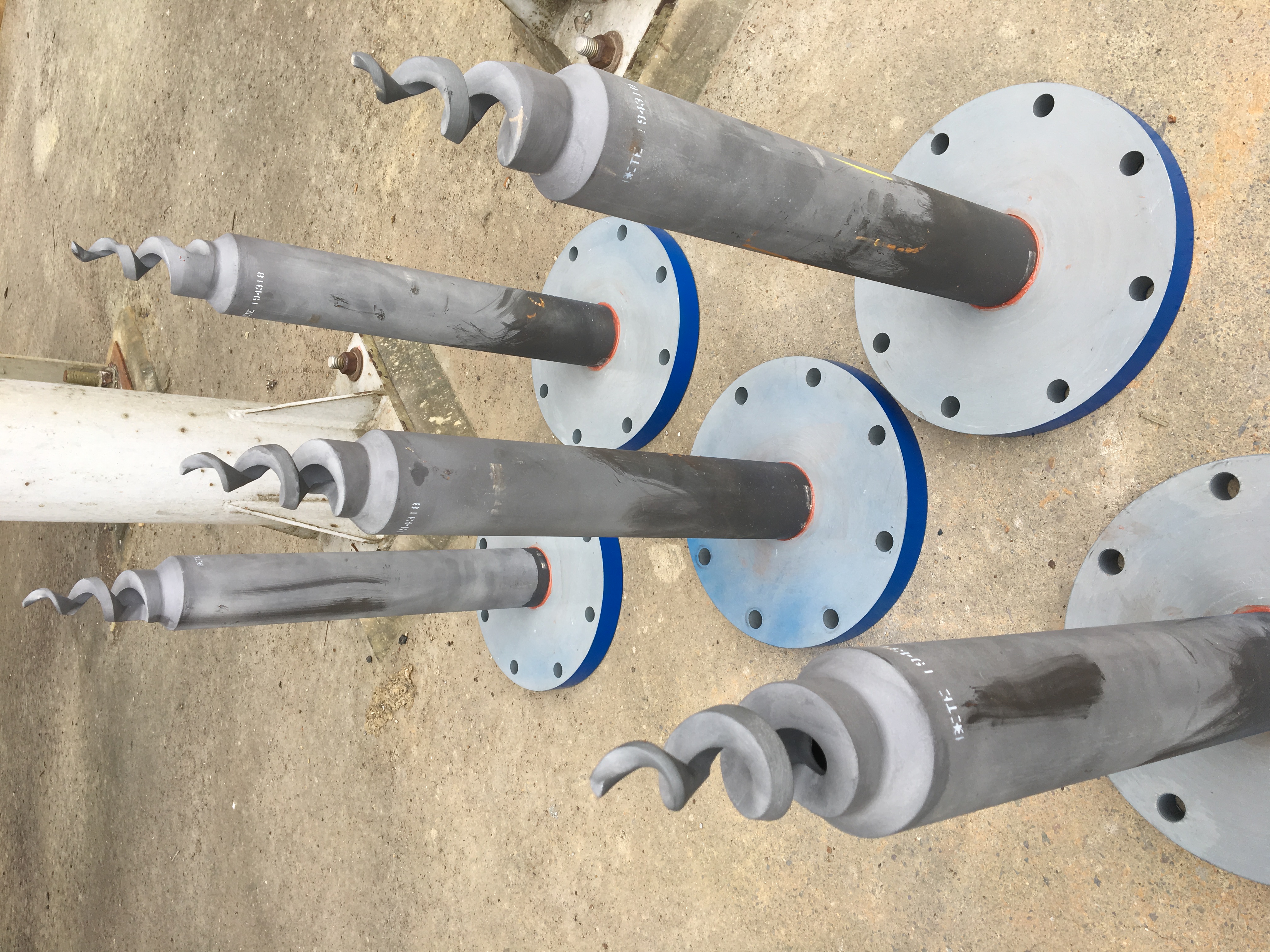|
SERN T
In rocketry, a SERN, which stands for single expansion ramp nozzle, is a type of physical linear expansion nozzle where the gas pressure transfers work only on one side. Traditional nozzles are axially symmetric, and therefore surround the expanding gas. Linear nozzles are not axially symmetric, but consist of a 2D configuration of two expansion ramps. A SERN could also be seen as a single sided aerospike engine. Many designs for space planes with scramjet engines make use of SERNs because of the weight reduction at large expansion ratios, or the additional lift at under-expansion. The X-43, a test vehicle in NASA's Hyper-X programme, is a flying example. One of the practical problems with the use of SERNs is the fact that they produce a pitching moment depending on the throttling of the engine, thereby requiring more control authority of the elevator An elevator (American English) or lift (Commonwealth English) is a machine that vertically transports people ... [...More Info...] [...Related Items...] OR: [Wikipedia] [Google] [Baidu] |
Nozzle
A nozzle is a device designed to control the direction or characteristics of a fluid flow (specially to increase velocity) as it exits (or enters) an enclosed chamber or pipe (material), pipe. A nozzle is often a pipe or tube of varying cross sectional area, and it can be used to direct or modify the flow of a fluid (liquid or gas). Nozzles are frequently used to control the rate of flow, speed, direction, mass, shape, and/or the pressure of the stream that emerges from them. In a nozzle, the velocity of fluid increases at the expense of its pressure energy. Types Jet A gas jet, fluid jet, or hydro jet is a nozzle intended to eject gas or fluid in a coherent stream into a surrounding medium. Gas jets are commonly found in gas stoves, ovens, or barbecues. Gas jets were commonly used for Gas lighting, light before the development of electric light. Other types of fluid jets are found in carburetors, where smooth calibrated orifices are used to regulate the flow of gasoline, fuel ... [...More Info...] [...Related Items...] OR: [Wikipedia] [Google] [Baidu] |
Aerospike Engine
The aerospike engine is a type of rocket engine that maintains its aerodynamic efficiency across a wide range of altitudes. It belongs to the class of altitude compensating nozzle engines. Aerospike engines were proposed for many single-stage-to-orbit (SSTO) designs. They were a contender for the Space Shuttle main engine. However, as of 2023 no such engine was in commercial production, although some large-scale aerospikes were in testing phases. The term ''aerospike'' was originally used for a truncated plug nozzle#In rockets, plug nozzle with a rough conical taper and some gas injection, forming an "air spike" to help make up for the absence of the plug tail. However, a full-length plug nozzle may also be called an aerospike. Principles The purpose of any engine bell is to direct the exhaust of a rocket engine in one direction, generating thrust in the opposite direction. The exhaust, a high-temperature mix of gases, has an effectively random momentum distribution (i.e., the ... [...More Info...] [...Related Items...] OR: [Wikipedia] [Google] [Baidu] |
Space Plane
A spaceplane is a vehicle that can fly and glide as an aircraft in Earth's atmosphere and function as a spacecraft in outer space. To do so, spaceplanes must incorporate features of both aircraft and spacecraft. Orbital spaceplanes tend to be more similar to conventional spacecraft, while sub-orbital spaceplanes tend to be more similar to fixed-wing aircraft. All spaceplanes as of 2024 have been rocket-powered for takeoff and climb, but have then landed as unpowered gliders. Four examples of spaceplanes have successfully launched to orbit, reentered Earth's atmosphere, and landed: the U.S. Space Shuttle, Russian Buran, U.S. X-37, and the Chinese Shenlong. Another, Dream Chaser, is under development in the U.S. As of 2024 all past and current orbital spaceplanes launch vertically; some are carried as a payload in a conventional fairing, while the Space Shuttle used its own engines with the assistance of boosters and an external tank. Orbital spaceflight takes place ... [...More Info...] [...Related Items...] OR: [Wikipedia] [Google] [Baidu] |
Scramjet
A scramjet (supersonic combustion ramjet) is a variant of a ramjet airbreathing jet engine in which combustion takes place in supersonic airflow. As in ramjets, a scramjet relies on high vehicle speed to compress the incoming air forcefully before combustion (hence ''ram''jet), but whereas a ramjet decelerates the air to speed of sound, subsonic velocities before combustion using shock cones, a scramjet has no shock cone and slows the airflow using shockwaves produced by its ignition source in place of a shock cone. This allows the scramjet to operate efficiently at extremely high speeds. Although scramjet engines have been used in a handful of operational military vehicles, scramjets have so far mostly been demonstrated in research test articles and experimental vehicles. History Before 2000 The Bell X-1 attained Supersonic speed#Supersonic flight, supersonic flight in 1947 and, by the early 1960s, rapid progress toward faster aircraft suggested that operational aircraft wo ... [...More Info...] [...Related Items...] OR: [Wikipedia] [Google] [Baidu] |
NASA X-43
The NASA X-43 was an experimental unmanned hypersonic aircraft with multiple planned scale variations meant to test various aspects of hypersonic flight. It was part of the X-plane series and specifically of NASA's Hyper-X program developed in the late 1990s. It set several airspeed records for jet aircraft. The X-43 is the fastest jet-powered aircraft on record at approximately Mach 9.6.Thompson, Elvia, Keith Henry and Leslie Williams"Faster Than a Speeding Bullet: Guinness Recognizes NASA Scramjet." ''NASA.'' Retrieved: August 1, 2011. A winged booster rocket with the X-43 placed on top, called a "stack", was drop launched from a Boeing B-52 Stratofortress. After the booster rocket (a modified first stage of the Pegasus rocket) brought the stack to the target speed and altitude, it was discarded, and the X-43 flew free using its own engine, a scramjet. The first plane in the series, the X-43A, was a single-use vehicle, of which three were built. The first X-43A was ... [...More Info...] [...Related Items...] OR: [Wikipedia] [Google] [Baidu] |
NASA
The National Aeronautics and Space Administration (NASA ) is an independent agencies of the United States government, independent agency of the federal government of the United States, US federal government responsible for the United States's civil list of government space agencies, space program, aeronautics research and outer space, space research. National Aeronautics and Space Act, Established in 1958, it succeeded the National Advisory Committee for Aeronautics (NACA) to give the American space development effort a distinct civilian orientation, emphasizing peaceful applications in space science. It has since led most of America's space exploration programs, including Project Mercury, Project Gemini, the 1968–1972 Apollo program missions, the Skylab space station, and the Space Shuttle. Currently, NASA supports the International Space Station (ISS) along with the Commercial Crew Program and oversees the development of the Orion (spacecraft), Orion spacecraft and the Sp ... [...More Info...] [...Related Items...] OR: [Wikipedia] [Google] [Baidu] |
Elevator (aircraft)
Elevators are flight control surfaces, usually at the rear of an aircraft, which control the aircraft's pitch, and therefore the angle of attack and the lift of the wing. The elevators are usually hinged to the tailplane or horizontal stabilizer. They may be the only pitch control surface present, and are sometimes located at the front of the aircraft (early airplanes and canards) or integrated into a rear "all-moving tailplane", also called a slab elevator or stabilator. Elevator control effectiveness The elevator is a usable up and down system that controls the plane, horizontal stabilizer usually creates a ''downward'' force which balances the nose down moment created by the wing lift force, which typically applies at a point (the wing center of lift) situated aft of the airplane's center of gravity. The effects of drag and changing the engine thrust may also result in pitch moments that need to be compensated with the horizontal stabilizer. Both the horizontal ... [...More Info...] [...Related Items...] OR: [Wikipedia] [Google] [Baidu] |
Nozzles
A nozzle is a device designed to control the direction or characteristics of a fluid flow (specially to increase velocity) as it exits (or enters) an enclosed chamber or pipe. A nozzle is often a pipe or tube of varying cross sectional area, and it can be used to direct or modify the flow of a fluid (liquid or gas). Nozzles are frequently used to control the rate of flow, speed, direction, mass, shape, and/or the pressure of the stream that emerges from them. In a nozzle, the velocity of fluid increases at the expense of its pressure energy. Types Jet A gas jet, fluid jet, or hydro jet is a nozzle intended to eject gas or fluid in a coherent stream into a surrounding medium. Gas jets are commonly found in gas stoves, ovens, or barbecues. Gas jets were commonly used for light before the development of electric light. Other types of fluid jets are found in carburetors, where smooth calibrated orifices are used to regulate the flow of fuel into an engine, and in jacuzzis or ... [...More Info...] [...Related Items...] OR: [Wikipedia] [Google] [Baidu] |




